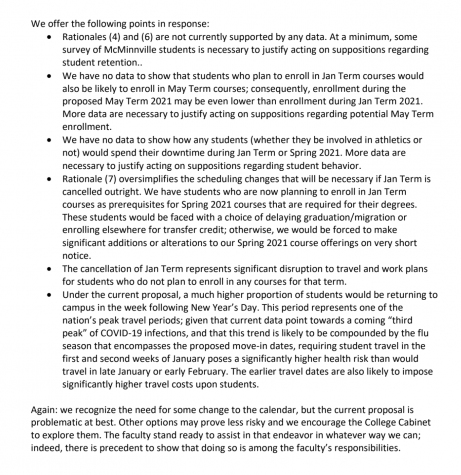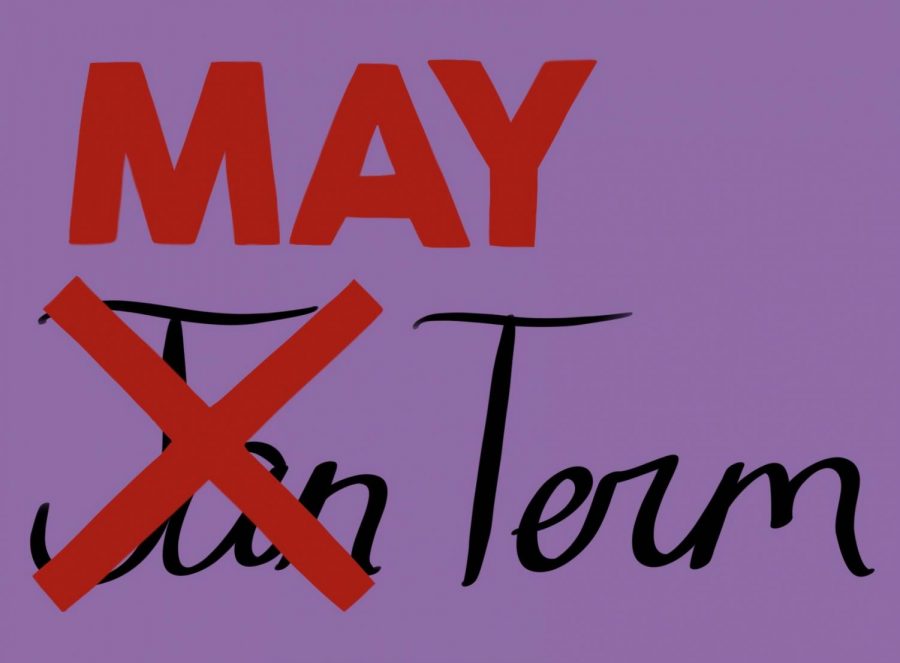Linfield alters spring schedules in hopes of accommodating COVID-19 health guidelines
Students adapt to changes announced to the spring schedule.
October 23, 2020
The administration announced a final decision about January and spring term schedules in the Linfield Ahead email on Monday evening. The email announcement confirmed that January term will be moved to May and spring semester will start January 18.
These changes will only impact the McMinnville campus and Online Continuing Education (OCE) schedules. The Portland campus will remain on their original schedule to allow for clinicals, the University Provost Susan Agre Kippenhan said.
The new plan also eliminates spring break in order to reduce the risk of spreading COVID-19.
However, student’s complaints about experiencing fall semester fatigue did not fall on deaf ears. “We know that students are tired, we know that they have been experiencing Zoom fatigue,” Agre Kippenhan said. “We cannot have a spring break because there is no way to guarantee that students will stay on campus.”
In compensation for the lack of a formal break, there will be days off “built into the week” throughout the semester, the provost said. These days will likely take place in the middle of the week as opposed to the weekend to discourage students from leaving campus.
Agre Kippenhan said it was necessary to adjust the schedule to allow more time for COVID-friendly move-in procedures at the start of spring semester.
Shifting the spring schedule will allow more time for test results to come back before classes start. In the fall, the university was not able to get every student’s results back before classes started.
“We need to allow for COVID occupancies and time for students to have phased move-ins. We are going to be testing all the students again,” she said.
The traditional schedule also includes a 10-day break between January term and spring semester. The break would potentially require the university to fund another round of testing at the end of the 10 days, “That would have been another time we would have had to try and keep kids on campus,” Agre Kippenhan said.
Additionally, the administration is concerned for students that choose to participate in both the January term and spring semester because they would be on campus for 20 weeks straight with no breaks.
The university announced this schedule change two weeks before students register for spring classes on Nov. 8. The provost said they did their best when it came to making a timely decision, but there were simply a lot of components to consider in the process.
Some students and faculty are concerned that pushing the January term to the spring will disrupt course sequencing.
One senior, Ashley Ingalls, faces anxiety over graduation, “If I don’t have Jan. term in January I don’t think I will be able to graduate in time,” she said.
Ingalls’s sport management major requires her to have two internships before graduation–one of her internships was with a high school sports team. “I’m worried that by May, the season will already be over,” she said.
As a member of the cheerleading team, Ingalls uses January term to help lighten her coarse load during the season. “I’ve taken a term all three years that I have been here and I wanted to take it this year as well,” she said.
By talking to people around campus, Ingalls found that the changes are impacting students and faculty, so Ingalls started a petition.
“I just hope to be a voice for the students. I have a lot of friends that need the extra month of January to help pay for their spring semester,” she said.
Ingalls also works for the Office of Admissions. “I have a pretty good relationship with President Davis,” she said. “So I felt comfortable going to Davis to share my frustrations.”
On Tuesday, Ingalls emailed President Davis. He emailed her back addressing her concerns.
“My goal is to get 500 faculty and student signatures that say they [students and staff] are not for this change,” she said.
Agre Kippenhan and the Vice President of Academic Affairs Susan Hopp encourage students to talk to their advisors and department chairs if the schedule changes offset their four year plan. “We are trying to be extra lenient this year because of the strange circumstances,” Hopp said.
The administration did its best to make a timely decision, but faced an unpredictable year themselves. “Unrealistically, a lot of us were looking at fall thinking ‘what if a great cure came in the fall?’ And now we know that none of that is going to be happening,” Agre Kippenhan said.
They started brainstorming ideas for a new spring schedule around September. Agre Kippenhan said these conversations included faculty perspective and opinion.
The Review received a letter from an anonymous source on Tuesday that claims faculty were not fully included in the decision. The letter details faculty concerns about the new spring schedule.
The letter was submitted by the Faculty Executive Council (FEC) to the administration on the Friday before the decision was announced.
Since scheduling plays such a big role in curriculum planning, it is typical that faculty design the semesters schedule in tandem with the administration. “It is for this reason that we request a greater role in revising the McMinnville academic calendar for Spring 2021,” the letter stated.
The letter continued, “Respectfully, we believe that the proposed changes pose a high risk for student retention and wellness.” Faculty recognizes the need for changes, but would like to hear more rationale from the administration.
The following is an excerpt from the letter containing points the faculty asked the administration to discuss and elaborate on before finalizing the proposed changes.

Among others, one faculty concern is that students returning during the nation’s peak travel periods will pose a greater risk of bringing COVID-19 back to campus.
Additionally, travel dates closer to New Year’s could mean more expensive ticket prices.
________
In reference to the previous article on this subject, The Linfield Review would like to clarify how the survey was conducted.
The Review gathered data from approximately 200 students on Wednesday and Thursday of last week– before the decision was finalized. Around 70% of students were members of the Fraternity and Sorority community. They responded through an online form that was sent out with the questions included on the graphic.
Additionally, about 30% of students were interviewed in person by our team of journalists, where students were free to share their opinion.
________
This article comes in tandem with a previous article that reported on the plans for spring semester. Read more about the proposal and students’ reactions here.
Anna Frazier and Emma Inge contributed reporting.

